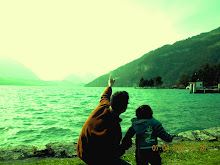Nothing excites me more during my travels than to sit somewhere incognito and watch life pass by; a small bylane or that street-corner in an unknown city. For a moment I too get to become a part of that scene and an observer of that flow of drama. If you literally translate life watching in my mother tongue, Bengali, it almost assumes a philosophical overtone – jibon-dorshon.
Here is a list of 10 of my personal favourites (in no particular order) for life watching –based on my one-and-half decades of travel around different parts of the world:
 3. Saint-Germain-des-Prés, Paris:No other place brings out the café-culture of Paris more vividly than Saint-Germain-des-Prés, the intellectual nerve-centre of Paris between the two wars. Featured in countless stories, films, and articles, the cafés and the streets here have witnessed the birth and demise of many movements – from Surrealism to Existentialism, and from non-narrative literature (Deridda, anyone?) to the French New Wave. Two of the most famous cafés here are Les Deux Magots and Café de Flore – at the corner of Boulevard Saint-Germain and Rue St. Benoit. The best time to visit is afternoon, when you can sit with a glass of wine and watch the Parisian life - and the hordes of tourists - pass by. Clientele in the past included folks like Jean Paul Sartre, Pablo Picasso, Ernest Hemingway, Albert Camus, and - well, the list goes on.
3. Saint-Germain-des-Prés, Paris:No other place brings out the café-culture of Paris more vividly than Saint-Germain-des-Prés, the intellectual nerve-centre of Paris between the two wars. Featured in countless stories, films, and articles, the cafés and the streets here have witnessed the birth and demise of many movements – from Surrealism to Existentialism, and from non-narrative literature (Deridda, anyone?) to the French New Wave. Two of the most famous cafés here are Les Deux Magots and Café de Flore – at the corner of Boulevard Saint-Germain and Rue St. Benoit. The best time to visit is afternoon, when you can sit with a glass of wine and watch the Parisian life - and the hordes of tourists - pass by. Clientele in the past included folks like Jean Paul Sartre, Pablo Picasso, Ernest Hemingway, Albert Camus, and - well, the list goes on.
Here is a list of 10 of my personal favourites (in no particular order) for life watching –based on my one-and-half decades of travel around different parts of the world:
1. Soho, London: Buzzing with beautiful cafés, Victorian pubs, and historic buildings, with avant-garde theatres and notorious strip-shows, Soho lies at the heart of Bohemian London. From Karl Marx to Dylan Thomas, from Sharon Stone to Kate Moss, nobody could escape its spell. You can spend hours sitting at one of the countless pubs here and watch people congregate from all over the world . It’s certainly one of the best places in the world to see the circus of life. I was fortunate enough to have my office here, right at the centre of Soho, for over a year.
2. Coffee House, Calcutta: This is probably the only institution of its kind in India: a relic not only of the city's deeply rooted colonial past but also of a time when Calcutta exploded with creativity in every field - from cinema to the arts, and from literature to economics. By the time I started going to Coffee House as a student in the mid-nineties it was already part its prime and yet, the sublime character of the place had its spell. I usually went in the evening with my friends, sat at a corner table with a good view, and watched the hall get filled up slowly with middle-aged men, cigarette smoke, and loud argumentative voices. Though I haven't visited Coffee House in recent years, but I still remember how I used to feel during those evenings - mind full of ideas, respiratory system chocked with nicotine, and a sense of enormous anachronism.
 3. Saint-Germain-des-Prés, Paris:No other place brings out the café-culture of Paris more vividly than Saint-Germain-des-Prés, the intellectual nerve-centre of Paris between the two wars. Featured in countless stories, films, and articles, the cafés and the streets here have witnessed the birth and demise of many movements – from Surrealism to Existentialism, and from non-narrative literature (Deridda, anyone?) to the French New Wave. Two of the most famous cafés here are Les Deux Magots and Café de Flore – at the corner of Boulevard Saint-Germain and Rue St. Benoit. The best time to visit is afternoon, when you can sit with a glass of wine and watch the Parisian life - and the hordes of tourists - pass by. Clientele in the past included folks like Jean Paul Sartre, Pablo Picasso, Ernest Hemingway, Albert Camus, and - well, the list goes on.
3. Saint-Germain-des-Prés, Paris:No other place brings out the café-culture of Paris more vividly than Saint-Germain-des-Prés, the intellectual nerve-centre of Paris between the two wars. Featured in countless stories, films, and articles, the cafés and the streets here have witnessed the birth and demise of many movements – from Surrealism to Existentialism, and from non-narrative literature (Deridda, anyone?) to the French New Wave. Two of the most famous cafés here are Les Deux Magots and Café de Flore – at the corner of Boulevard Saint-Germain and Rue St. Benoit. The best time to visit is afternoon, when you can sit with a glass of wine and watch the Parisian life - and the hordes of tourists - pass by. Clientele in the past included folks like Jean Paul Sartre, Pablo Picasso, Ernest Hemingway, Albert Camus, and - well, the list goes on.
(7 more to come)









